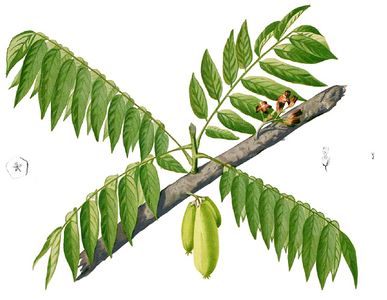Averrhoa bilimbi
De PlantUse Français
Averrhoa bilimbi L.
| Ordre | Oxalidales |
|---|---|
| Famille | Oxalidaceae |
| Genre | Averrhoa |
2n = 22, 24
Origine : Moluques
sauvage et cultivé
| Français | bilimbi |
|---|---|
| Anglais | bilimbi |
Résumé des usages
- fruit acide utilisé en condiment, achars ou chutneys
- fruit utilisé pour nettoyer les métaux
- médicinal
Sommaire
Description
Noms populaires
| français | bilimbi, cornichonier ; blinblin (Haïtï) |
| anglais | bilimbi, cucumber tree, tree sorrel |
| espagnol | mimbro (Amérique centrale) ; grosella china (Cuba) |
| bengali | bilimbi, blimbi (Wealth of India) |
| gujerati | blimbu (Wealth of India) |
| hindi | bilimbi (Wealth of India) |
| malayalam | bilimbi, irumbanpuli, vilimbi (Wealth of India) |
| marathi | bilembi (Wealth of India) |
| tamoul | pilimbi, pulichakkai (Wealth of India) |
| telugu | bilimbi, pulusu-kayalu (Wealth of India) |
| Indonésie, Malaysia | belimbing asam, blimbing wuluh, belimbing buluk (PROSEA) |
| Philippines | kamias, iba (tagalog) (PROSEA) |
| Cambodge | trâlông töng (PROSEA) |
| Thaïland | taling pling (PROSEA) |
| Vietnam | khê tau (PROSEA) |
- Voir l'étymologie de bilimbi.
Classification
Averrhoa bilimbi L. (1753)
Cultivars
Histoire
Le bilimbi est surtout cultivé dans le sud tropical de l'Asie. Son expansion en Inde doit être relativement récente, car il y porte un peu partout son nom malais reconnaissable.
Il a été introduit de Timor en Jamaïque en 1793, d'où il s'est peu après répandu en Amérique tropicale : Cuba, Puerto Rico, Trinidad, Amérique centrale, Vénézuela, Colombie, Equateur, Surinam, Guyane, Brésil, Hawaï.
Il a été introduit aux Mascareignes en 1764 et au Queensland (Australie) vers 1896.
Usages
Le bilimbi est trop acide pour être mangé cru. Il est essentiellement utilisé en conserve, pour préparer des achars ou des chutneys, ou en accompagnement de viandes.
Références
- Chauvet, Michel, 2018. Encyclopédie des plantes alimentaires. Paris, Belin. 880 p. (p. 514)
- Le Bellec, F & V. Renard, 1997. Le grand livre des fruits tropicaux. Chevagny-sur-Guie, Orphie. 192 p.
- Morton, J. 1987. Bilimbi. p. 128–129 In: Fruits of warm climates. Julia F. Morton, Miami, Fl. en ligne à Purdue


